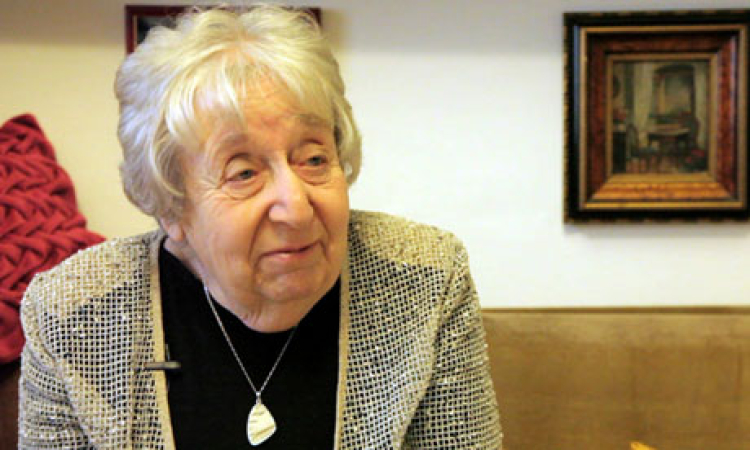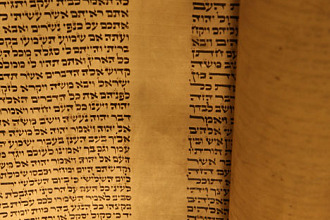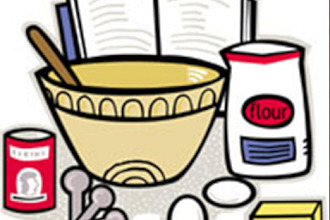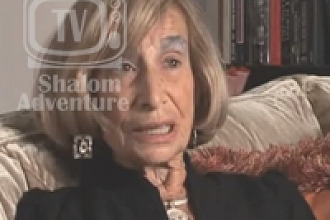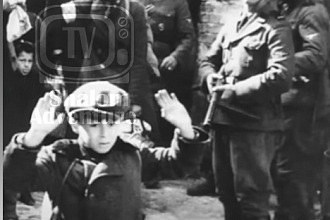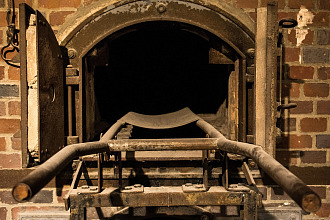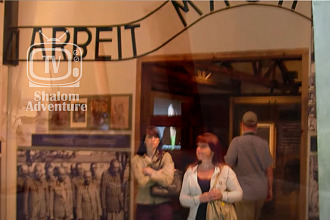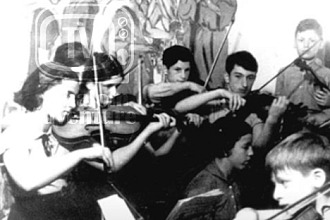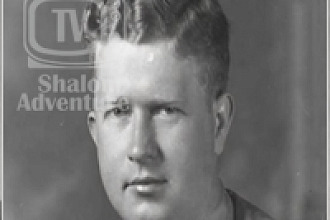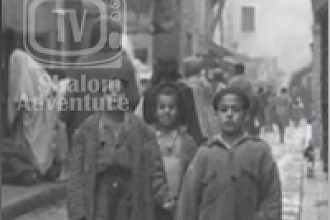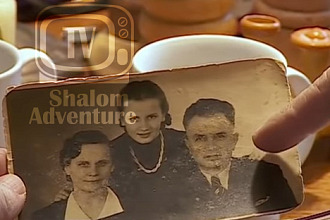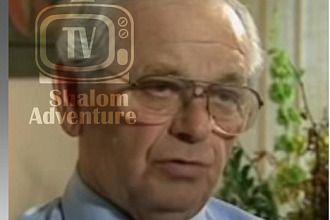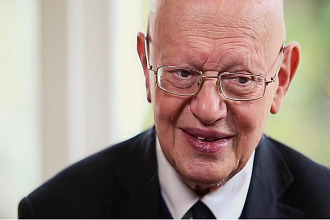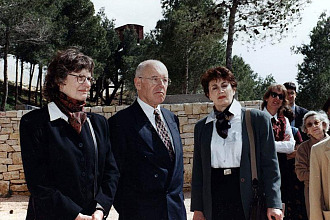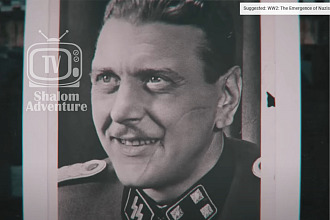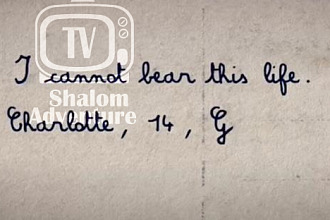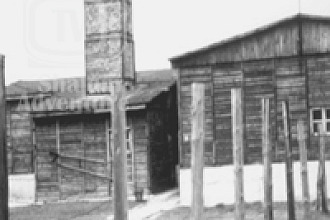In 1944, Helga Weiss came to terms with the idea of dying – with one important condition. She was only 14 years old and had never been strongly religious, but as she waited in a queue at Auschwitz she prayed she wouldn't die after her mother. She couldn't face being left alone.
Helga is one of only 100 children to survive Auschwitz out of the 15,000 sent there from the concentration camp at Terezín, north of Prague. Altogether, between 1941 and 1945, she and her mother were sent to four camps: Terezín, Auschwitz, Freiberg and Mauthausen.
The first was Terezín, where they spent three years, sleeping two or three to a bed that was really too small for one, with little to eat and to keep out the cold. But sharing with her mother made the impossible bearable. "We had only one blanket," says Helga. "But we covered ourselves with our coats. We were together and it was a great help."
She closes her eyes, and folds her arms tightly about herself.
We are in Helga Weiss's living room on the fourth floor of an apartment building in Prague. At 83, she still climbs the steep stairs each day and is a lively, friendly presence, surrounded by family photographs and paintings produced during her career as an artist. Her late husband, Jírí Hošek, was a musician who played double bass with the Czech Radio Symphony Orchestra, and her son, Jírí, is a cellist, as is her granddaughter Dominika.
Helga was born in this flat and it has always been her home, apart from the four years she spent in Nazi concentration camps. It was ransacked and occupied during the war but there are echoes of life as it was before the war. The piano in the corner, for instance, sits where her father's once did.
Otto Weiss was a talented aspiring musician but as a soldier in the First World War, he sustained hand and arm injuries and went on to work in a bank. He married his wife, Irena, and in 1929 Helga was born. Those early years were happy. Otto encouraged his daughter musically, but she had no obvious talent for it; her gift was for art. She still has one of her very early sketch pads, which shows she chose subjects "perhaps other children don't. I always painted what I saw – a man in a meat store," for instance.
As war loomed, the eight-year-old Helga began to keep a diary in words and pictures. The first pages record the growing Nazi threat: air raid alarms, arrests, the expulsion of Jewish children from state schools, adults – including her father – losing their jobs, yellow Stars of David had to be sewn on clothes, and the constant, claustrophobic talk of "transports". It was because of the political situation, says Helga, that she remained an only child – a decision her father made.
In December 1941, soon after Helga's 12th birthday, the authorities came for the family. They were sent to Terezín, a walled 18th-century garrison town, also known during the war by its German name, Theresienstadt. Many of Helga's uncles and aunts were sent there too. Terezín was essentially a vast camp used as a transit hub for tens of thousands of Jews sent to Auschwitz and Treblinka.
Helga and her mother had no idea what lay ahead. They thought the war would soon be over. "We were allowed 50kg of luggage so we took just our clothes and something important to us. I took two very small dolls, a pad, watercolours and crayons," she says.
At Terezín, Otto was sent to the men's barracks and Helga stayed with her mother. Later, a Kinderheim – children's home – was set up and though she was frightened to leave Irena, Helga moved into a room with girls of her own age. Conditions were slightly better there and the group, "tried to stay human beings and be young," she says. They organised dances and celebrated birthdays and religious holidays – they once made a potato gateau as a treat, from food scraps they had managed to save.
One of Helga's happier sketches shows the girls gathering round a food parcel, jostling to see the contents. But the first drawing she made is a jolly picture of two children building a snowman – she smuggled it through to her father who sent back a crucial message: "Draw what you see."
She took his advice and began to record life in the camps. The pictures show queues for food; a bleak, basic washroom; a girl ill with tuberculosis; the crowded waiting room in the emergency clinic; people on stretchers; bread transported in a hearse marked "Welfare for the young".
Another drawing marks the birthday of her friend, Francka. The girls had been born in the same maternity ward, and the sketch shows them as babies in 1929, in their shared bunk bed in 1943, and in 1957, wheeling prams together. The last drawing is accompanied by a note to say that Francka died in Auschwitz before her 15th birthday.
Despite the horrors and strictures of Terezín – starvation rations, disease, the lice and bed bugs that crawled across their faces – there was a thriving cultural life. Many musicians had smuggled in instruments and one sketch shows families gathered around a violin trio giving a concert in a dormitory.
At Terezín, Helga met her first boyfriend, Ota, an orphan and chemistry student. He was in his mid-20s, she was not yet 15. "It was a half-childish love," she says. "We walked together and held hands ... and I remember the exact place in Terezin where we first kissed." She beams. "But nothing more happened than kissing."
In September 1944, the Germans announced that 5,000 men would be sent to build a new ghetto. Helga's Uncle Jindra would be in the first group, her father and Ota in the second. Helga describes the day her father left in her diary, the corners of his mouth twitching as he tried to smile, hands shaking as he held her. Then he was gone.
Three days later, she and Irena left. Just in time, she got her diary and a novel and some poetry by her father to her Uncle Josef, who worked in the records department at the camp. He bricked them into a wall to hide them.
Helga and her mother were sent to Auschwitz, where they joined the notorious queue as they arrived: older women and mothers with young children to the left, those deemed able to work to the right. To survive, it was essential to end up on the right. Prisoners who knew the fate that lay ahead on the left whispered warnings: "Don't say you are too young, don't say you are ill – say you are able to work. Don't say you belong together, that you are mother and child," remembers Helga."
She resolved to say she was older than 14; her mother would pretend to be younger. In fact, the SS man didn't ask questions and sent them both to the right. "He pointed – I don't know if it was luck, fate, a miracle. I have friends who are still alive – they are the same age as I am – but their mothers were [sent to the left]. So I was lucky twice. Not only that I was not sent, but that I was together with my mother."
Next day, at roll call, the women were addressed in German. "The speech was very long – I asked my mother to translate. She said, 'Oh, he says we are in an extermination camp.'"
Helga laughs explosively, a sound still full of shock and incredulity. They hadn't known about the gas chambers, the death camps. "We arrived and saw smoking chimneys – we thought it was a factory."
Other prisoners enlightened them – the smoke was rising from the camp crematorium. They were told to strip naked and their heads were shaved. Helga didn't recognise her own mother until she heard her voice.
Her 10 days at Auschwitz were worse than the three years at Terezín, but Helga suspects it was harder still for her mother. She remembers being outside, shaved head freezing, and Irena reaching over to cup her bare scalp. It was all the comfort she could offer.
From Auschwitz, they were sent to Freiberg, a subcamp of Flossenbürgconcentration camp, where they worked as slave labour for five months, polishing aeroplane parts. Then came a 16-day transport by rail toMauthausen in Austria. Irena was so weak she could hardly stand and both suffered from frostbite, lice and constant, raging thirst. Rumours flew about the war's end and some women escaped, but Helga couldn't be sure her mother was fit enough to try. In one four-day period they had nothing to eat but two potatoes, half a cup of tea and two spoons of sugar.
Along the route, news arrived that Berlin had fallen.
At Mauthausen,they went without food for five days. Had there been just one more day before peace was declared, Helga suspects her mother would not have survived. Days later, on 5 May 1945, the camp was liberated by the Allied forces.
She and Irena returned home to Prague and began to look for Otto. His name didn't appear on the registration lists for any of the camps other than Terezín. In the first months, they found it unbearable to be alone together in the flat, which was so full of memories of their life together before the war. In the evenings they walked the streets together until it was time to sleep.
Helga continued her Terezín diary, recording everything that happened after they moved on. It's written in the present tense because she was still caught up in the experience, she says.
The diary has been published as she wrote it in the 1940s, as it was found at the bottom of a drawer. The sheaf of yellow papers was given to Venetia Butterfield, a British publisher who heard about it in 2010 when Helga came to London for a concert to commemorate Terezín.
In the prologue of the book, Helga explains that although "the writing is childish, the style prolix, naive," she felt editorial changes would have affected the authenticity of the story. "May readers treat this diary charitably and accept it for what it is," she writes; an important record of life in the concentration camps, which adds to the memories of other child diarists, including, of course, Anne Frank.
Irena didn't want Otto to be declared dead but after a year the certificates were sent out, regardless. Helga believes someone may have known what happened to him, but didn't want to tell them. Some stories just weren't passed on. Her Uncle Jindra, for example, was sent from Auschwitz to Mauthausen and experienced such cold that his legs had to be amputated. He died as a result. His wife knew he had died and where, but was never told those details.
There was no question of Helga and her mother living apart after the war. Irena remained single and when Helga married, her husband shared the apartment with them. Irena helped with her son and daughter, and lived until she was 84. Last year, Helga's daughter remarked that Irena had never smiled. "I never thought about it, but maybe she didn't. Maybe she had no reason."
The legacy of the war has affected her children, she says. Her daughter can't bear to hear of anything ugly, and her son is "terribly anxious," she says. "When I am alone, I have to contact him twice a day."
But one of her granddaughters has been exploring her Jewish roots and it is probably this younger generation that will benefit initially from Helga's extraordinary journal of survival.
With her forthright attitude, and pride in her family, Helga's concern is, as always, for the future, and how people survive. There is only one moment during our interview when she wells up with emotion, but they are tears of happiness. Just last week, she says, her great-granddaughter got her first tooth.
Helga's Diary: A Young Girl's Account of Life in a Concentration Camp, by Helga Weiss, is published by Viking, £16.99. To order a copy for £13.59 with free UK p&p go to guardian.co.uk/bookshop or call 0330 333 6846
Originally found here
Posted on Shalom Adventure by: Verna-Lee Small

